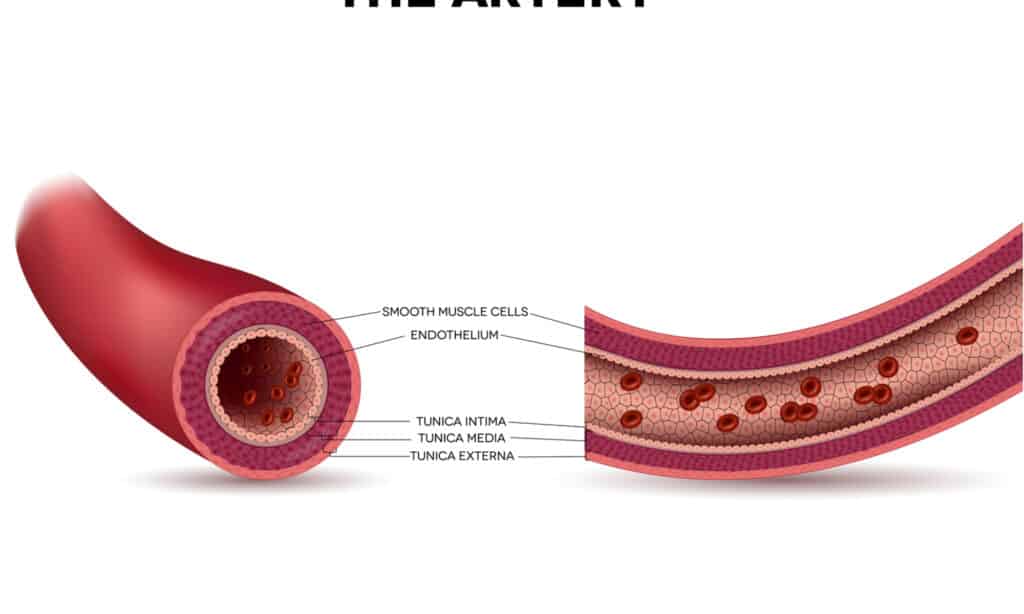The human body is complex. That concept holds especially true when we examine the cardiovascular system. The basic purpose of this system is to pump blood throughout the body. Blood vessels are important components of the cardiovascular system, and arteries are the largest blood vessels. Arteries have the greatest diameter and the thickest walls of all blood vessels. So, what is the largest artery in the body?
We’re going to explore this topic by examining arteries and identifying the largest one in the body. We’ll show you where it’s at, what it does, and even introduce you to other large arteries in the body!
What Is an Artery?

The human body has several large arteries to transport blood.
©Tefi/Shutterstock.com
Arteries are blood vessels that transport oxygen-rich blood away from the heart and transport it to other parts of the body. Of course, some exceptions exist to this definition, but it’s a good working conceptualization of arteries’ purposes.
Arteries are the largest of all blood vessels in the body, and several of them can be found throughout humans. The arteries aren’t the final blood vessels used to transport blood, though. Blood travels from arteries into arterioles and then into capillaries, delivering blood to various parts of the body.
Capillaries also lead back to small blood vessels called venules, and venules flow into veins that make their way back to the heart.
The Anatomy of an Artery
The outer portion of an artery is called the tunica externa or the tunica adventita, and it’s made of elastic tissue and collagen fibers. The largest arteries in the body also have small blood vessels called vasa vasorum located in the tunica externa.
The next layer inward is called the tunica media, which is made of smooth muscle cells, more elastic tissue, and collagen fibers. The muscle cells help the blood vessel maintain its integrity while facing high pressure.
The final layer of an artery is called tunica intima. This portion of the artery actually touches the flowing blood. The tunica intima is made of endothelial cells and collagen. Lastly, the actual cavity in an artery is known as the lumen. This is the portion of the artery through which blood flows.
What’s the Largest Artery in the Body?

The aorta is located near the top of the heart.
©pirke/Shutterstock.com
The aorta is the largest artery in the body. It originates in the left ventricle of the heart and helps distribute blood throughout the body. On average, an adult’s aorta is over one foot long and measures about an inch in diameter at its widest point. However, the diameter of the aorta shrinks as it approaches the pelvis.
The aorta has several segments and branches. From the left ventricle of the heart, the aorta rises in a section called the ascending aorta. From there, it reaches the aortic arch, a portion of the artery that arches to the anatomical left.
The artery branches in this section of the aorta, rising above the heart with the left subclavian artery, left common carotid artery, and the brachiocephalic trunk stemming from it. The brachiocephalic trunk branches into the right subclavian artery and right common carotid artery.
Past the aortic arch and on the descent, the artery is called the descending aorta. From there, the aorta continues to descend in the body, where it becomes the abdominal aorta. This part of the aorta branches into several different arteries that have a much smaller diameter than the widest portion of the aorta.
What Are Veins?
Now that we know about the largest artery in the body, it’s important to discuss the counterpart to arteries. For the most part, veins work to carry deoxygenated blood back to the heart.
Of course, there are some exceptions to this definition. For example, the pulmonary veins are responsible for carrying somewhat oxygenated blood from the lungs to the heart. Still, the basic definition should help you understand what veins do in the human body.
Veins are less muscular than arteries and tend to be closer to the surface of the skin in most cases. Interestingly, many veins only allow for blood to flow one way. They possess valves to prevent blood from flowing in reverse.
What Are Other Large Arteries in the Body?
Although the aorta is the largest artery in the body, it’s not the only large artery in the body. Take a look at a few of the other major arteries that you should know about. You’ll be interested in the interconnectivity of the entire cardiovascular system!
Main Pulmonary Artery
The diameter of the main pulmonary artery is about 1.1inches or 2.72 cm. The main pulmonary artery splits into the right and left main pulmonary arteries. They are responsible for carrying deoxygenated blood from the right side of the heart to the lungs.
Subclavian Arteries
The subclavian arteries are a pair of arteries that branch off from the aortic arch. While the left subclavian artery stems directly from the aortic arch, the right subclavian artery stems from the brachiocephalic artery, an artery that splits into the right subclavian and right common carotid arteries. This artery’s diameter is about 1cm or 0.39in.
Common Femoral Artery
The femoral artery supplies blood to the thigh and leg. The average diameter of the common femoral artery is about .98cm or 0.38in.
Common Carotid Artery
The common carotid artery refers to either the left or right common carotid arteries that help supply the head with oxygenated blood. These large arteries have diameters that equal about 0.61-0.65cm or roughly 0.25in
These are some of the largest arteries in the human body. They each supply valuable oxygenated blood to various portions of the body and are substantial in size.
The human body is a marvel that can only function so well because of the intricate blood vessels in its cardiovascular system. The aorta is particularly interesting. Not only is the aorta the largest artery in the body, but it serves as the base from which many other large arteries stem.
Of course, the cardiovascular system is much more complex than we’ve established here. All of the definitions in this article are incredibly simplified because it’s impossible to overstate the intricacy of human blood vessels.
The photo featured at the top of this post is © restyler/Shutterstock.com
Thank you for reading! Have some feedback for us? Contact the AZ Animals editorial team.






